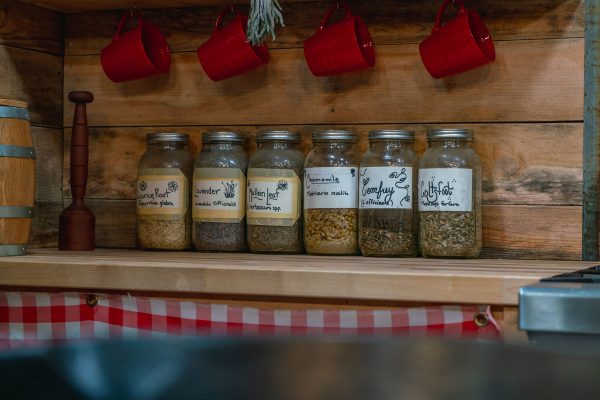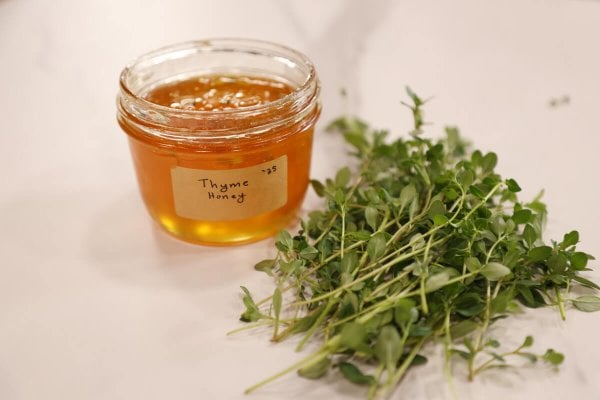Not to be confused with the quick pickling method of refrigerator zucchini pickles or the classic water bath canning method, this recipe uses fermentation. Read on to learn how you can make this quick and easy zucchini pickles recipe.

Why I Love Zucchini Pickles
Zucchini is always included when we are planning a vegetable garden because our goal is to grow a year’s worth of food.
Zucchini plants are known to be so productive that there is a joke among gardeners to be sure to lock your doors in squash season or your neighbors will sneak zucchini into your house when you’re not looking! We laugh, but our kids aren’t always so amused.
“Zucchini again?” was a phrase often heard around the dinner table at my house until I learned a valuable lesson: It is the cook’s job to turn that overabundant vegetable into new, exciting, and delicious foods.
Fortunately, there are several ways to prepare zucchini beyond shredding it to hide it in a flexible frittata or zucchini cake, including making zucchini flour and harvesting the flowers to make this zucchini blossoms recipe.
I love making zucchini pickles because the fermentation process provides the benefit of preservation as well as naturally boosting our immune system. The health benefits of traditional eating are important to us.
Just like the milder fermented ketchup, pizza beans, fermented ginger carrots, and homemade lacto-fermented mayonnaise, zucchini pickles are also a great ferment to introduce to kids who are more sensitive to strong flavors.

What Are Zucchini Pickles
While cucumbers and distilled white vinegar as a pickling liquid are traditionally used to make easy refrigerator pickles or canned pickles, this recipe combines zucchini with fermentation for long-term preservation to keep fresh in the refrigerator for up to a month.
The result is a similar crisp texture and zingy flavor you come to love with traditional cucumber pickles.
Ways to Use Zucchini Pickles
This summertime treat (with a probiotic punch) is delicious enough to stand on its own as a quick snack, but here are a few more ways to enjoy zucchini pickles:
- Burgers – Don’t forget to pack a jar of your zucchini pickles for your next BBQ or outdoor cookout.
- Sandwiches – Did you make a double batch of this easy meatloaf or have leftover homemade corned beef? Dill pickled zucchini reinvents these leftovers into specialty deli-worthy sandwiches and pairs well with all the classics; turkey, ham, roast beef, etc. And if you’re really brave, you can try a peanut butter and zucchini pickle sandwich!
- Salads – Use zucchini pickles in place of any salad recipe that usually calls for cucumber pickles, such as tuna salad, egg salad, macaroni salad, or chicken salad.
- Cheese Platter – Zucchini pickles complement this delicious marinated dream cheese served with cured meats and crackers.

The Homestead Kitchen
This tutorial for zucchini pickles was featured in issue No.12 of the Homestead Kitchen magazine. If you are ready to master your homestead kitchen, this affordable magazine was curated with you in mind.
It’s packed full of cream-of-the-crop homesteading information, including recipes, DIY instructions, inspirational stories, homesteading hacks, book reviews, gardening tips, kids’ projects and more. We can’t wait to share it with you!
If you’re ready to spend less time striving in the kitchen and more time enjoying it then subscribe today to have your monthly copy delivered right to your mailbox.

Supplies Needed
- Small Bowl – You will need a small bowl or cup to dissolve the salt in ½ cup of warm water before adding it to the jars.
- Jars – One half-gallon Mason jar or four pint-sized jars is sufficient for this recipe. Homesteading Hack: If you don’t have Mason jars on hand, check out these best fermenting vessels before purchasing supplies.
- Fermentation Weights – Fermentation weights are perfect for this, but a zip-top bag full of water or a small ramekin work also.
- Lid – You will need a lid that can fit loosely for the fermentation process but securely for storage. We love these fermentation lids that make fermenting simple!
Ingredients Needed
- Zucchini – Use fresh, young zucchini for best results.
- Garlic Cloves – For the most flavorful garlic, learn how to grow garlic here.
- Tea – This recipe will work with loose-leaf black or green tea. The tannins in the tea are what help keep the zucchini crisp.
- Fresh Dill – You can use ½ teaspoon of dried dill weed or a teaspoon of dill seed instead of fresh.
- Filtered Water – Always use fresh, clean water free of chlorine, chloramines and fluoride when fermenting. Homesteading Hack: If you don’t have a water filter, you can heat your water and bring it to a boil to evaporate the chlorine. Just allow the boiling water to cool to room temperature before using it.
- Salt – You can use pickling salt, but I recommend using Redmond Real Salt. (Using that link for Redmond Salt will automatically give you 15% off your order!)
- Ground Turmeric (optional) – Adds a nice color to your pickles and helps preserve them longer. Homesteading Hack: To add a spicy kick to your zucchini pickles, add a teaspoon of whole black peppercorns, ½ teaspoon of red pepper flakes, and 1 teaspoon mustard seed.

How to Make Zucchini Pickles
- Wash and slice zucchini into rounds. Homesteading Hack: The blossom end of the zucchini has enzymes that can make your pickles soft. Discard and feed them to your backyard chickens or put them in your compost pile.
- Add the dill, garlic, tea and zucchini slices to a half-gallon jar or split between multiple wide-mouth pint jars leaving enough room for the fermentation weight.
- To make the pickle brine, mix 1⁄2 cup of warm water with the salt and stir until the salt has dissolved. Once the salt has dissolved completely, add the remaining water. Add the turmeric to the brine and mix well.
- Pour the brine into the jar with the zucchini. There should be enough to submerge the zucchini under the brine. If not, make more brine and add it to the jar.
- Weigh the vegetables down with fermentation weights, a zip-top bag full of water, or a small ramekin so they remain completely under the brine. No need to remove air bubbles, just make sure the brine completely covers the vegetables.
- Cover the jar loosely with a lid and store it in a cool, dry place away from direct sunlight for three days.
- Once the brine is cloudy (typically day 3 or 4), try a pickle to see if it’s to your liking. If it’s not quite “pickle-y” enough, allow them to ferment for another 24 hours before testing again. (Expect them to be sour and smell like pickles.)
- Once the zucchini tastes how you would like it to, store the jar with a secured lid in the refrigerator for up to a month.
Did you make this recipe? If so, please leave a star rating in the recipe card below. Then, snap a photo and tag us on social media @homesteadingfamily to show us how you use your zucchini pickles!

Fearless Fermenting
Did you know that you can make more vegetable ferments in less time than it takes to heat your canner? In my Fearless Fermenting Video Workshop, I’ll teach you everything you need to know to confidently make amazing ferments every time!
In this class, you will receive…
- 45-minute Fearless Fermenting Video Workshop
- 2 “Recipe Walk-Through” videos for step-by-step instruction
- Fermenting Troubleshooting Video
- The 5 Rules of Successful Vegetable Ferments
As a bonus, you will also receive the downloadable (and printable!) 25-page Fearless Fermenting Guide and our top family favorite fermented veggie recipes! Sign up now, and start fermenting today! If you’re not ready to dive into a class, grab our FREE Fearless Fermenting Guide to get started now.

Other Articles You May Enjoy
- Homemade Fermented Ginger Carrots
- Crunchy Pickled Snap Peas Recipe
- Lacto-Fermented Green Beans Tutorial (aka: Pizza Beans)
- Fermented Ketchup (Easy, Homemade, Probiotic & Kids Love It)
- Easy Homemade Lacto-Fermented Mayo

Quick & Easy Zucchini Pickles Recipe
Ingredients
- 2 lbs zucchini use fresh, young zucchini for best results
- 4 whole garlic cloves minced
- 2 teaspoons tea loose leaf black or green tea
- 2 sprigs fresh dill or 1/2 teaspoon dill weed
- 2 pints filtered water
- 2 tablespoons salt
- 1/2 teaspoon ground turmeric
Instructions
- Wash and slice zucchini into rounds.
- Add the dill, garlic, tea and zucchini slices to a half-gallon jar or split between multiple wide-mouth pint jars leaving enough room for the fermentation weight.
- To make the pickle brine, mix 1⁄2 cup of warm water with the salt and stir until the salt has dissolved. Once the salt has dissolved completely, add the remaining water. Add the turmeric to the brine and mix well.
- Pour the brine into the jar with the zucchini. There should be enough to submerge the zucchini under the brine. If not, make more brine and add it to the jar.
- Weigh the vegetables down with fermentation weights, a zip-top bag full of water, or a small ramekin so they remain completely under the brine. No need to remove air bubbles, just make sure the brine completely covers the vegetables.
- Cover the jar loosely with a lid and store it in a cool, dry place away from direct sunlight for three days.
- Once the brine is cloudy (typically day 3 or 4), try a pickle to see if it’s to your liking. If it’s not quite “pickle-y” enough, allow them to ferment for another 24 hours before testing again. (Expect them to be sour and smell like pickles.)
- Once the zucchini tastes how you would like it to, store the jar with a secured lid in the refrigerator for up to a month.
Notes
- The blossom end of the zucchini has enzymes that can make your pickles soft. Discard and feed them to your backyard chickens or put them in your compost pile.


















